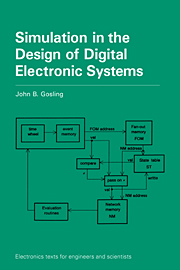Book contents
- Frontmatter
- Contents
- Preface
- 1 An introduction to the simulation of electronic systems
- 2 Electronic computer aided design (ECAD) systems
- 3 Design for testability
- 4 Exercising the design in simulation and test
- 5 Input/output of simulation and specification of models
- 6 Simulation algorithms
- 7 Models and model design
- 8 Timing verification
- 9 Fault simulation
- 10 Simulator features and extensions
- Appendix
- References
- Index
5 - Input/output of simulation and specification of models
Published online by Cambridge University Press: 05 June 2012
- Frontmatter
- Contents
- Preface
- 1 An introduction to the simulation of electronic systems
- 2 Electronic computer aided design (ECAD) systems
- 3 Design for testability
- 4 Exercising the design in simulation and test
- 5 Input/output of simulation and specification of models
- 6 Simulation algorithms
- 7 Models and model design
- 8 Timing verification
- 9 Fault simulation
- 10 Simulator features and extensions
- Appendix
- References
- Index
Summary
Input and output of simulation
When a complete system is being simulated there are relatively few external inputs – a start key, a break key and possibly some inputs from various peripherals such as tape drives, sensors etc. Similarly, there are few outputs. In these cases the arrangements to pass ‘test data’ to the simulation can be very crude.
The main purpose of simulation is to find errors in a design. To simulate a complete system and expect to find detailed errors is very difficult, especially as different parts of the design may be at different stages of development. It is important to be able to simulate sub-units independently of the total design in order to get the majority of problems solved before trying to integrate the complete system (Fig. 1.4). Some means of supplying and controlling test vectors is required.
In this form of testing there will be copious output, which comes in two forms. The first is the values of primary output signals – the product of a multiplier, for example. These values can be compared with a set of ‘expected’ values to check the overall operation. If the results of simulation are different to the expected values then it is necessary to
check the expected values – Note!!!
if the expected values seem correct, trace back through the logic to find where the error occurred and hence find the design error.
- Type
- Chapter
- Information
- Simulation in the Design of Digital Electronic Systems , pp. 96 - 110Publisher: Cambridge University PressPrint publication year: 1993



